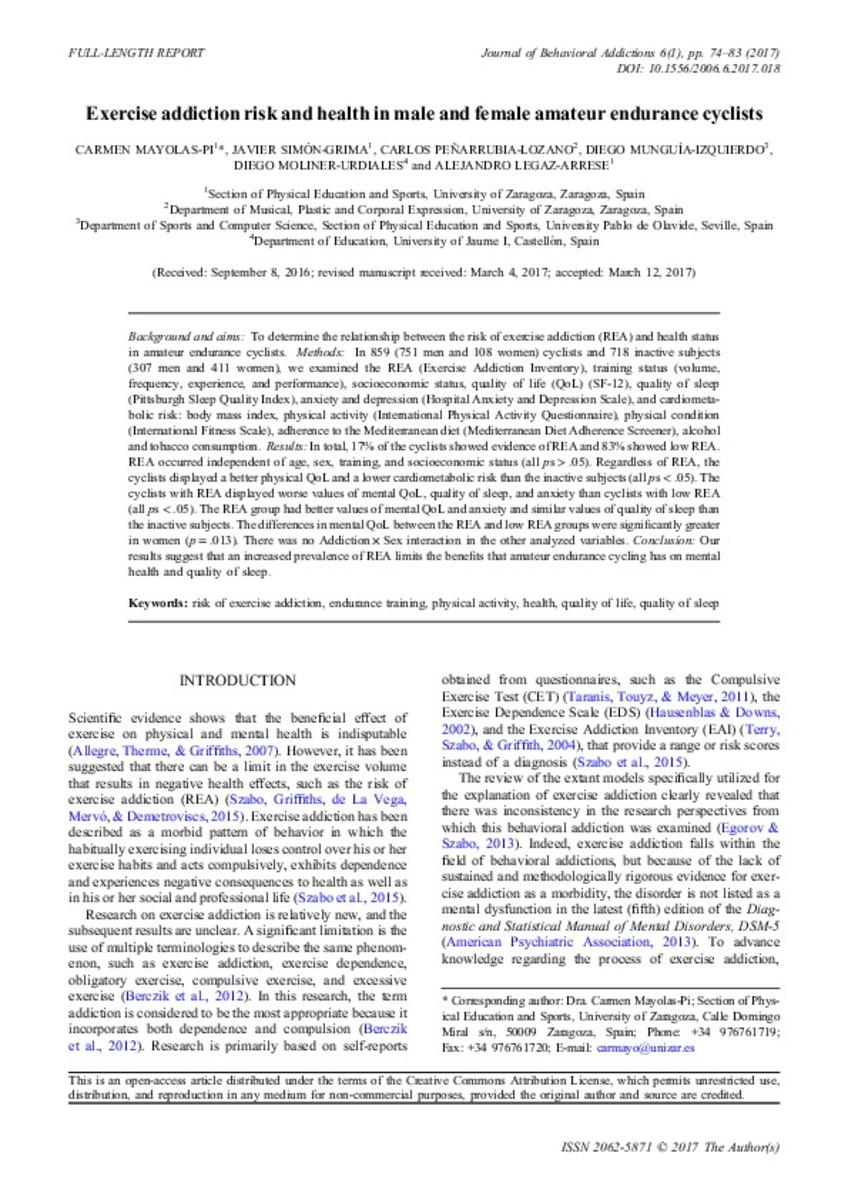Mostrar el registro sencillo del ítem
Exercise addiction risk and health in male and female amateur endurance cyclists
| dc.contributor.author | Mayolas Pi, María del Carmen | |
| dc.contributor.author | Simón Grima, Javier | |
| dc.contributor.author | Peñarrubia Lozano, Carlos | |
| dc.contributor.author | Munguía Izquierdo, Diego | |
| dc.contributor.author | Moliner-Urdiales, Diego | |
| dc.contributor.author | Legaz Arrese, Alejandro | |
| dc.date.accessioned | 2017-06-02T10:34:47Z | |
| dc.date.available | 2017-06-02T10:34:47Z | |
| dc.date.issued | 2017-03 | |
| dc.identifier.citation | MAYOLAS-PI, Carmen, et al. Exercise addiction risk and health in male and female amateur endurance cyclists. Journal of Behavioral Addictions, 2016, vol. 6, no 1, p. 74-83. | ca_CA |
| dc.identifier.uri | http://hdl.handle.net/10234/167787 | |
| dc.description.abstract | Background and aims: To determine the relationship between the risk of exercise addiction (REA) and health status in amateur endurance cyclists. Methods: In 859 (751 men and 108 women) cyclists and 718 inactive subjects (307 men and 411 women), we examined the REA (Exercise Addiction Inventory), training status (volume, frequency, experience, and performance), socioeconomic status, quality of life (QoL) (SF-12), quality of sleep (Pittsburgh Sleep Quality Index), anxiety and depression (Hospital Anxiety and Depression Scale), and cardiometabolic risk: body mass index, physical activity (International Physical Activity Questionnaire), physical condition (International Fitness Scale), adherence to the Mediterranean diet (Mediterranean Diet Adherence Screener), alcohol and tobacco consumption. Results: In total, 17% of the cyclists showed evidence of REA and 83% showed low REA. REA occurred independent of age, sex, training, and socioeconomic status (all ps > .05). Regardless of REA, the cyclists displayed a better physical QoL and a lower cardiometabolic risk than the inactive subjects (all ps < .05). The cyclists with REA displayed worse values of mental QoL, quality of sleep, and anxiety than cyclists with low REA (all ps < .05). The REA group had better values of mental QoL and anxiety and similar values of quality of sleep than the inactive subjects. The differences in mental QoL between the REA and low REA groups were significantly greater in women (p = .013). There was no Addiction × Sex interaction in the other analyzed variables. Conclusion: Our results suggest that an increased prevalence of REA limits the benefits that amateur endurance cycling has on mental health and quality of sleep. | ca_CA |
| dc.description.sponsorShip | This work was partially supported by the “Cátedra Real Madrid,” European University of Madrid (project: P2016/19RM). | ca_CA |
| dc.format.extent | 10 p. | ca_CA |
| dc.format.mimetype | application/pdf | ca_CA |
| dc.language.iso | eng | ca_CA |
| dc.publisher | Akadémiai Kiadó | ca_CA |
| dc.relation.isPartOf | Journal of Behavioral Addictions 6(1), 2017 | ca_CA |
| dc.rights | © 2017 Akadémiai Kiadó Zrt. | ca_CA |
| dc.rights | Atribución 4.0 España | * |
| dc.rights.uri | http://creativecommons.org/licenses/by-sa/4.0/ | * |
| dc.subject | risk of exercise addiction | ca_CA |
| dc.subject | endurance training | ca_CA |
| dc.subject | physical activity | ca_CA |
| dc.subject | health | ca_CA |
| dc.subject | quality of life | ca_CA |
| dc.subject | quality of sleep | ca_CA |
| dc.title | Exercise addiction risk and health in male and female amateur endurance cyclists | ca_CA |
| dc.type | info:eu-repo/semantics/article | ca_CA |
| dc.identifier.doi | http://dx.doi.org/10.1556/2006.6.2017.018 | |
| dc.rights.accessRights | info:eu-repo/semantics/openAccess | ca_CA |
| dc.relation.publisherVersion | http://akademiai.com/doi/abs/10.1556/2006.6.2017.018 | ca_CA |
Ficheros en el ítem
Este ítem aparece en la(s) siguiente(s) colección(ones)
-
EDU_Articles [501]








